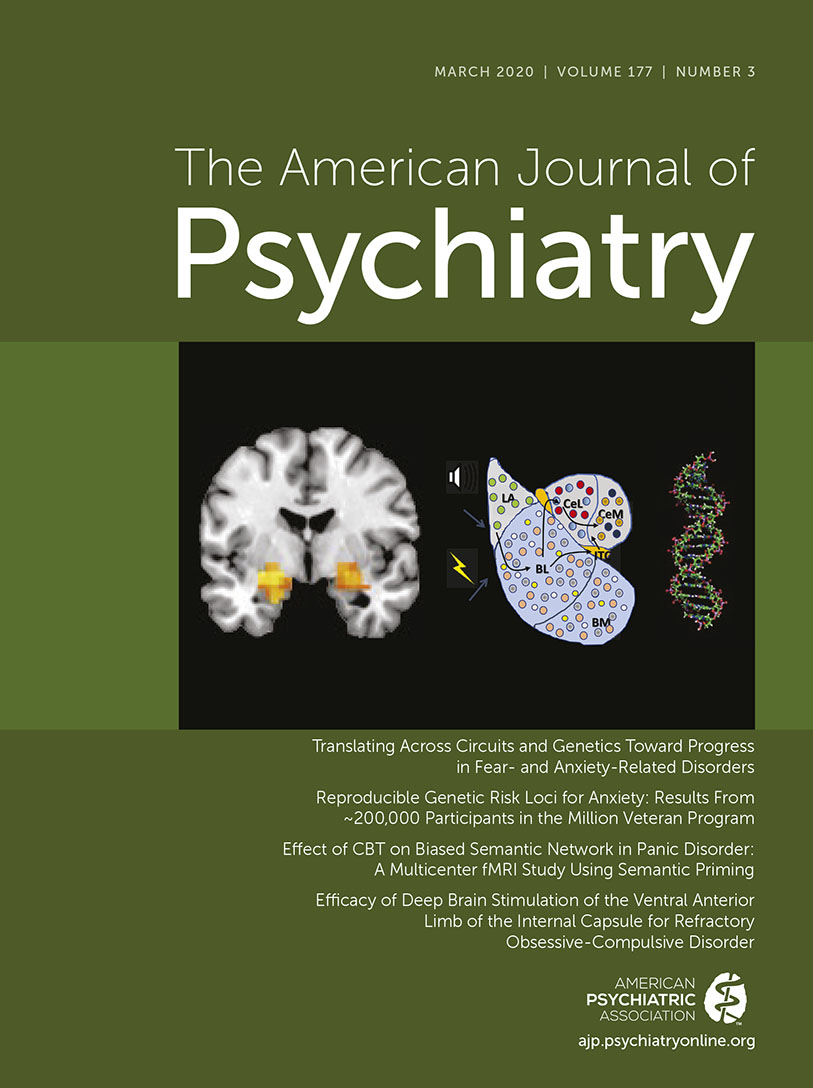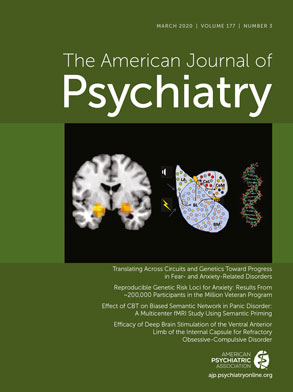Anxiety disorders are among the most common psychiatric illnesses (
1), and anxiety as a symptom is ubiquitous across all psychiatric conditions. In addition, anxiety disorders are highly comorbid with one another and with other psychiatric illnesses. Anxiety disorders usually begin during childhood, result in significant suffering and disability, and are associated with a chronic and recurrent lifetime course. According to data from the National Comorbidity Survey Replication study (
2) of individuals at least 18 years of age, estimates of the 12-month prevalence of anxiety disorders are 18%, and like mood disorders, there is an approximate two-to-one female prevalence during women’s reproductive years. In children and adolescents, the lifetime prevalence of anxiety disorders is estimated to be between 15% and 20% (
3). Regardless of the primary psychiatric illness, the presence of clinically significant anxiety in general predicts worse outcomes. Although effective pharmacological and psychotherapeutic treatments exist, numerous individuals fail to get better, and many of the individuals who do respond require long-term treatment. There is a definite need to better understand the underlying brain mechanisms that will inform new neuroscientifically based treatment approaches.
It is noteworthy that with the advent of DSM-5, there have been changes in the classification of anxiety. Within the category of anxiety disorders, DSM-5 includes separation anxiety disorder, selective mutism, social anxiety disorder, panic disorder, agoraphobia, generalized anxiety disorder, substance/medication-induced anxiety disorder, and anxiety disorder due to another medical condition. In contrast to DSM-IV, posttraumatic stress disorder (PTSD) and acute stress disorder are now considered within the trauma- and stressor-related disorders category, and obsessive-compulsive disorder (OCD) is in a separate category. Regardless of the current classification system, PTSD and OCD have much in common with the disorders that, in DSM-5, are considered to be “true” anxiety disorders.
Anxiety can be adaptive as it functions to signal potential threats or dangers in the environment, and it facilitates accompanying coping strategies. Because experiencing anxiety is critical for survival, the brain and physiological systems that mediate fear and anxiety have been highly evolutionarily conserved. In clinical practice, anxiety disorders are categorically defined. However, anxiety—along with its physiological and behavioral manifestations—can also be conceptualized as a dimensional characteristic. Regardless of whether individuals meet full criteria for a diagnosis, pathological or maladaptive anxiety is characterized by anxiety that is overly intense or occurs in situations or contexts that otherwise would not be expected to elicit anxiety. Features of pathological anxiety include excessive worry, hypervigilance, physiological arousal, and avoidance behaviors. Regarding its dimensional nature, it is important to emphasize that although anxiety disorders are highly prevalent, there are many individuals who struggle with pathological anxiety who do not meet full disorder criteria.
Studies demonstrate that the propensity to develop anxiety disorders is approximately 30%−50% heritable (
4), and as with other psychiatric disorders, the genetics are complex and involve numerous genes that each contribute small amounts to the overall genetic risk. The nongenetic factors that contribute to the risk for anxiety disorders, which are not specific to anxiety, involve early experiences such as parenting style (
5), social learning (
6), and childhood adversity, which can include stress exposure, maltreatment, and lower socioeconomic status (
7,
8). Personality traits that are associated with increased reactivity to stress and negative affect, such as neuroticism, have also been associated with anxiety and depressive disorders (
9).
The earliest antecedents of pathological anxiety can be recognized in childhood. Studies in young children have identified an anxiety-related trait-like phenotype that is among the best early-life predictors of the later development of psychopathology. The initial work by Jerome Kagan (
10) established that behavioral inhibition in response to strangers or novel situations is a trait-like temperamental feature that presents with a wide range of individual differences and is relatively stable over time. Subsequent studies demonstrated that when extreme, this trait confers a three- to fourfold increased risk for the likelihood of developing social anxiety disorder (
11,
12) and is also a considerable risk factor for developing other anxiety disorders, depression, and comorbid substance abuse. Research in young nonhuman primates that is focused on a related phenotype, anxious temperament, has identified core components of the neural circuit (the central nucleus of the amygdala and posterior orbitofrontal cortex) that may play a causal role in mediating this early-life risk (
13). These findings are consistent with mechanistic rodent (
14) and human neuroimaging studies (
15) that have identified anxiety-related neural pathways. Because pathological anxiety can be reliably identified in childhood, an opportunity exists to develop early-life novel interventions aimed at mitigating the developmental and lifelong consequences that result from anxiety disorders.
This issue of the
Journal is focused on new developments in the understanding and treatment of anxiety, stress-related disorders, and OCD and leads off with an outstanding overview by Dr. Kerry Ressler, a leader in investigating the neurobiology of anxiety disorders from McLean Hospital at Harvard Medical School. Dr. Ressler provides a beautifully integrated glimpse into how we can begin to translate basic studies that define anxiety-related neural circuits and molecules to the care of our patients (
16). This overview is followed by original research articles that present potentially important and exciting findings that address 1) the genetics of anxiety, 2) patterns of functional brain connectivity (resting-state functional MRI [rsfMRI] and EEG) that characterize and subtype patients with PTSD, 3) how cognitive-behavioral therapy (CBT) may work in patients with panic disorder, and 4) the efficacy of neural circuit modulation with deep brain stimulation (DBS) in patients with refractory OCD.
In the largest genome-wide association study (GWAS) performed in relation to anxiety, Levey and colleagues (
17) present data from approximately 200,000 participants from the Million Veteran Program. In this study, the authors examined anxiety dimensionally as well as categorically. After correcting for multiple comparisons, five genome-wide signals were found implicating different genes, many of which were replicated when the investigators compared their results with previous findings from other cohorts. One of the most statistically significant genes that was found functions to regulate the expression of other genes, implying the potential for this gene to have broad effects across numerous systems. A particularly exciting finding was an association between the Corticotropin Releasing Hormone Receptor 1 gene (
CRHR1) and anxiety, as this gene is centrally involved in hypothalamic-pituitary-adrenal regulation, and preclinical studies have demonstrated a mechanistic role for the amygdala Corticotropin Releasing Hormone system in mediating fear and anxiety responses. Another exciting finding was the association between the estrogen receptor alpha gene (
ESR1) and anxiety. An accompanying editorial by Dr. Jordan Smoller, a leader in psychiatric genetics from Massachusetts General Hospital and Harvard University, highlights the importance of these findings and also comments on methodological issues for genetic studies that include the depth of phenotyping and the ancestral heritage from which the GWAS study population is drawn (
18). In his general overview on anxiety disorders, Dr. Ressler discusses the
CRHR1 finding and how this can be understood in relation to the clinical trials that have failed to demonstrate therapeutic benefit of
CRHR1 antagonists.
Two articles in this issue both involving Amit Etkin’s group at Stanford University with Charlie Marmar’s group at New York University are focused on patterns of brain connectivity in patients with PTSD. In one study of combat veterans, Toll et al. (
19) used 64-channel resting EEG measures combined with new analytic methods to enhance the accuracy of detecting localized EEG signals within the brain to assess connectivity alterations. Findings demonstrated decreased connectivity in the theta-band range across numerous brain sites, with the strongest findings in the orbital and anterior middle frontal gyri. Importantly, these EEG findings were related to measures of cognitive performance. Because of the relative ease and cost of acquiring EEG data, along with advances in increasing the reliability of locating the source of electrical signals in the brain, the authors suggest that these types of measures have the potential to be readily translated to the clinic. In the second article, by Maron-Katz et al. (
20), the authors examined brain connectivity in combat veterans using rsfMRI. This was combined with a novel analytic approach that focused on connectivity patterns that were found in healthy control subjects but that in patients with PTSD demonstrated a greater range of individual differences. This approach emphasizes focusing on brain alterations at the individual, as compared with the group, level. Findings from this study revealed two subgroups of PTSD patients with different patterns of functional connectivity involving the sensorimotor, frontoparietal, and visual networks. These subgroups also differed on clinical and cognitive measures. In her editorial, Dr. Lisa Shin, a professor from Tufts University whose work is focused on understanding neural alterations in PTSD, further elaborates on the potential of this brain-based “bottom-up” approach to define homogeneous, clinically relevant PTSD subgroups (
21).
The next two articles in this issue are relevant to understanding the efficacy and mechanisms of treatments in patients with panic disorder and refractory OCD. In the article by Yang and colleagues (
22), fMRI is used in patients with panic disorder to understand how CBT can affect brain systems that underlie semantic priming for words associating panic triggers with panic symptoms. In a large group of patients with panic disorder, the authors demonstrate enhanced coupling between trigger-related and symptom-related words at psychological and behavioral levels. By performing the study in the scanner, the authors also show that in subjects with PTSD, this priming effect is associated with activation of the anterior cingulate cortex. Finally, in assessing a subset of patients who received CBT, it was found that a reduction in symptoms occurred along with decreased strength of coupling between trigger- and symptom-related words and reduced activity in the anterior cingulate cortex. In his editorial, Dr. Josh Cisler, an expert in trauma-related neural processes from the University of Wisconsin, comments on the interpretation of these findings in relation to understanding the brain changes that underlie the positive effects of CBT and exposure therapy (
23).
The final article in this issue reports on the 12-month efficacy of DBS in 70 patients with refractory OCD (
24). Here, in a nonblinded study, Denys and coworkers demonstrate a 40% reduction in OCD symptoms along with reductions in anxiety and depression after stimulation of the ventral anterior limb of the internal capsule. Importantly, in this large group of patients, the DBS treatment generally appeared to be safe and well tolerated. These data reflect successful attempts to modulate circuitry hypothesized to be involved in mediating the symptoms of OCD in a very refractory and disabled population. Drs. Wayne Goodman, Eric Storch, Jeffrey Cohn, and Sameer Sheth present an editorial that provides a critical view of the findings, addresses how DBS may be working in relation to hypothesized OCD-related alterations in cortical-striatal-thalamic pathways, and presents ideas about how to improve DBS methods (
25).
In conclusion, this issue of the Journal provides a foundation for understanding the latest genetic, molecular, and neural circuit findings as they relate to mechanisms underlying anxiety disorders with relevance for new treatment development. These disorders are among the most prevalent psychiatric disorders, not to mention the pathological anxiety that is found in many individuals who do not meet criteria for anxiety disorders and that is commonplace across other psychiatric illnesses. Because of the adaptive nature of anxiety and its familiarity as part of the human experience, some have viewed anxiety disorders as not as severe as other psychiatric illnesses. However, the amount of suffering and disability associated with these highly prevalent illnesses cannot be overestimated. In addition to the need for new, more effective treatments, efforts should be focused on developing novel early-life interventions for at-risk children. Such interventions have the potential not only to reduce the consequences of pathological anxiety but also could mitigate the deleterious effects of chronic anxiety on psychosocial and cognitive development.

